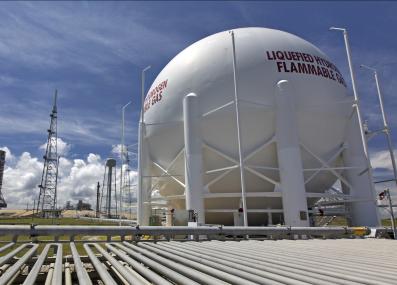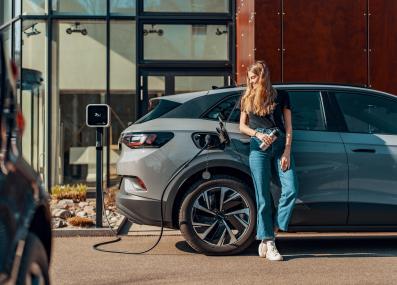Have a question?
Why have electric vehicles won out over hydrogen cars (so far)?
Today's battery electric vehicles are cheaper than hydrogen-powered ones, and they also need less new infrastructure.
September 11, 2023
In the early 2000s, hydrogen was hot. Vehicles using hydrogen-powered fuel cells rivaled electric vehicles with batteries (EVs) as the best way to clean up the car industry by replacing climate-polluting gasoline. But today, EVs are way ahead: the big car companies are rapidly electrifying their lineups, while only a few hydrogen cars are available.
A few key factors have led battery-powered cars to dominance, says Sergey Paltsev, a senior research scientist at the MIT Energy Initiative and a deputy director of the MIT Joint Program on the Science and Policy of Global Change. One is cultural taste: undeniably, he says, the rise of Tesla in the 2010s propelled the popularity of EVs around the world.
The big factor, though, is cost. The two mainstream hydrogen cars on sale in the U.S. today, the Toyota Mirai and Hyundai Nexo, start at around $50,000 and $60,000, respectively. A growing number of EVs cost less, thanks to the falling price of lithium-ion batteries. (And though EVs are still generally pricier than gas cars, government incentives can help to cover the difference.) Research by Paltsev and his students has found that the lifetime cost of ownership for a fuel cell car has come down in recent years, but remains high largely because of the cost of hydrogen fuel. They found the total cost of ownership for hydrogen was around 40 percent higher than a comparable gasoline vehicle, and about 10 percent more than an EV.1
EVs have another crucial advantage: A vast, nationwide electrical system already exists. A nationwide transition to electric vehicles creates big challenges, including the need to build a charging network and make plenty of extra (hopefully clean!) electricity to power all these cars and trucks. But, Paltsev says, those tasks are less herculean than building a new hydrogen economy. “You don’t really need to create another infrastructure for electric cars.”
Hydrogen has its own advantages. The fuel can be pumped in less time than it takes to charge an EV battery, and it can deliver longer driving ranges. Hydrogen more closely resembles the pump-and-go experience everyone knows from using gasoline. However, that experience would require creating an enormous amount of hydrogen and then moving it, via pipelines or trucks, to refueling stations all over the country. (And no, we can’t use the pipelines we already have.)
Should the world have chosen hydrogen cars over EVs? For EVs to make the maximum impact in cutting climate-warming carbon dioxide (CO2), the electrification of the car fleet must go hand-in-hand with “decarbonizing” the electric grid so those cars run on clean energy. “Even if it's a fully decarbonized grid, electric cars are still not zero-emission vehicles,” says Paltsev. “We still have that remainder for battery production, for minerals, for transportation. That number is also not trivial—it's much smaller than for internal combustion, but it's not zero.”
However, hydrogen has its own issues. Nearly all the hydrogen used today is extracted from natural gas, in a process that creates CO2 as a byproduct. Carbon capture systems can be used to keep that CO2 out of the atmosphere (a setup experts call “blue hydrogen”), but that makes already-pricey hydrogen even more expensive. The gold standard would be “green hydrogen”: a process that uses clean electricity to extract hydrogen from water. But today, this is a costly way to make hydrogen—and just as EVs raise the demand for new clean electricity to fill up our cars, green hydrogen requires new clean electricity to produce hydrogen.
None of this is to say hydrogen is finished as a clean vehicle fuel. As batteries continue to drop in price, says Paltsev, their next logical move would be into heavy-duty vehicles. Yet it is not clear that the driving ranges and recharging times of EVs will mesh with the world of long-haul trucking. Hydrogen, with its long driving ranges, could prove a better candidate. And if the nation builds out hydrogen refueling stations to support trucking, that push would support passenger vehicles, too. (Currently, Paltsev says, fuel cell vehicles are limited primarily to California, which has most of the country’s few hydrogen stations, and countries like China, Japan, and Germany.)
Innovations to make hydrogen cleaner and cheaper could help make fuel cell vehicles competitive once again. So, too, could changes in the EV market. For example, Paltsev says, batteries depend on minerals mined overseas and sometimes under problematic conditions. A shortage in those materials, or geopolitical turmoil in the countries that produce them, could raise the price of EVs—and make made-in-the-U.S.A. hydrogen appealing by comparison.
Thank you to Robert Pryor of Glen Cove, New York, for the question. You can submit your own question to Ask MIT Climate here.
1 "Hydrogen powered cars and trucks: Is there a role for them in the electrified U.S. future?" MS Thesis, MIT System Design and Management Program, 2021.











